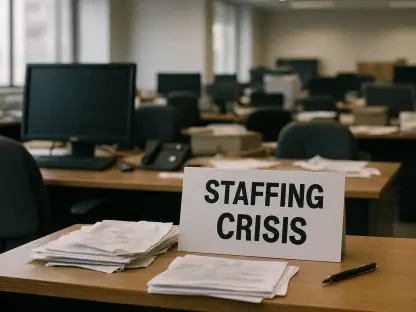In recent years, extreme heat has emerged as a significant occupational hazard, posing substantial threats to workers across the United States. With 2024 being recorded as the hottest year to date, impacting 17 states, the urgency for proactive and protective measures cannot be overstated. As the climate continues to shift and temperatures soar, workers in various sectors are left increasingly susceptible to heat-induced ailments and occupational dangers, making fatalities more likely. This pressing issue calls for decisive action—especially at the state level—to ensure enhanced protections are established, given the glaring inadequacies in current federal regulations.
Increasing Occupational Risks and Economic Fallout
Health Implications of Rising Temperatures
Heat-related illnesses such as heat exhaustion and heat stroke present immediate threats to the well-being of workers, particularly those in outdoor and physical labor-intensive roles. Exposure to extreme heat exacerbates underlying health conditions and can lead to life-threatening situations. Beyond individual health concerns, the broader ramifications of heat hazards ripple through the economy. Not only does workers’ health experience the impact, but productivity sharply declines as workers are forced to take leave, resulting in potential financial losses. The healthcare system also faces increased pressure with heightened demands for medical care, adding to the workers’ compensation claims amid a backdrop of diminished productivity.
The cascading economic effects further strain both individual financial stability and broader economic indicators. Businesses see declines in efficiency, and the costs associated with addressing heat-related health issues escalate. Given these impacts, it is imperative that both immediate and strategic responses are crafted to prevent long-term economic detriment.
Economic Effects of Productivity Losses
Heat-induced illnesses extend beyond health risks, leading to decreased productivity as workers are unable to perform their duties efficiently. This drop in productivity incurs significant financial implications. Businesses not only suffer from reduced output but are also burdened with elevated healthcare costs and an increase in workers’ compensation claims. These economic pressures affect the overall economy as labor efficiency wanes. The ripple effects of reduced productivity are seen in economic metrics, as a less efficient labor force can significantly impact the nation’s economic stability.
Moreover, the economic ramifications of extreme heat are amplified when addressing absenteeism due to illness. With employees requiring time off to recover, there is a dual burden of reduced workforce capacity and increased expenses related to medical care. As extreme heat continues to pose significant risks, the need for comprehensive protective measures becomes paramount to safeguard both workers’ health and economic interests.
Exploring Federal and State Interventions
Federal Oversight and Challenges
The Occupational Safety and Health Administration (OSHA) serves as the backbone of workplace safety in the United States, providing overarching frameworks meant to ensure worker safety across various exposures. However, it has historically lacked specific mandates addressing extreme heat hazards. Despite the Biden administration’s attempts in 2024 to propose federal standards targeting heat-related risks, prior experiences under the Trump administration highlighted that such rules may remain unfinalized, leaving workers vulnerable. This regulatory gap places the responsibility squarely on state leaders, compelling them to craft solutions at the state level.
The existing federal approach offers a broad but insufficient safety net, necessitating innovative and impactful state-level interventions. States have the opportunity to craft policies tailored specifically to their unique geographical and climate conditions, potentially setting benchmarks for others to follow. The lack of stringent federal guidelines inspires states to design measures specifically focused on heat-intensive environments, thereby offering a solution to a growing concern.
Comparison of State-Level Initiatives
Comparing federal guidelines with state-level initiatives reveals the disparities in the approach toward safeguarding workers from extreme heat. State-implemented OSHA-approved plans vary in effectiveness and coverage but must meet minimum federal standards. Some states have adopted ambitious plans that surpass federal requirements, closing the regulatory gap left by the absence of a designated federal rule. Additionally, these states set a precedent for action by crafting interventions that align closely with their respective climates and economic contexts.
Through initiatives that emphasize worker safety, states gain the ability to implement protections that resonate with local concerns. As more states consider adopting similar models, the possibility of a cohesive national standard becomes increasingly feasible. Addressing extreme heat at the state level provides a dynamic approach that considers specific regional challenges, while capturing the potential to elevate worker safety across the nation.
Proposing Effective State-Level Safety Measures
States with Heat Protection Policies
A select few states have led the charge in establishing protections against extreme heat risks, creating vital safeguards for their workforce. Notable among these are California, Colorado, Maryland, Minnesota, Nevada, Oregon, and Washington. Each of these states has introduced diverse approaches aimed at mitigating the effects of extreme heat, setting a benchmark for others to follow. This disparity highlights the innovative strategies employed at the local level, where policies are thoroughly tailored to address the specific risks faced by different sectors within their jurisdictions.
California, for instance, has developed comprehensive directives that oversee employer responsibilities in maintaining workplace safety during heat waves. The state mandates thorough heat injury prevention plans, emphasizing water availability, rest periods, and emergency protocols. These measures animate the possibilities for states yet to implement protections, suggesting paths forward inspired by successful models.
Recommendations for States Yet to Implement Protections
For states that have yet to enact robust protections against extreme heat, several recommendations emerge as guiding principles to bolster worker safety. For instance, states could require employers to develop comprehensive injury and illness prevention plans (HIIPs), encompassing essential elements like water provision and shade creation. Recognizing the importance of acclimatization, policies should advocate for measures that facilitate gradual heat exposure for workers.
Standards should leverage the WetBulb Globe Temperature (WBGT) measurement for accurate assessments of workplace heat risks. Unlike the traditional heat index, WBGT provides nuanced evaluations by considering additional factors like solar radiation. Paid rest breaks should be obligatory, tailored to heat conditions, ensuring that workers have ample opportunity to recuperate while aligning with fair labor practices. Training initiatives should be accessible across languages, overcoming barriers while educating workers on heat risks and preventive measures.
Additionally, states should consider implementing buddy systems to monitor workers for signs of heat-related illnesses. Emergency protocols, including communication systems and cooling resources, ensure readiness to act during heat emergencies. Each of these recommendations aims to comprehensively address the multifaceted challenges posed by extreme heat, equipping states with the tools to better protect their workforce.
Evaluating Broader Trends in Heat Governance
State Interventions and Consensus Perspectives
The prevailing consensus advocates for a critical role of states in mitigating the impacts of extreme heat through regulatory measures. With federal protections incomplete, states are urged to proactively adopt or enhance worker protections. California stands out as a leader in implementing pioneering measures that others may emulate. By focusing on state-driven action, the potential economic benefits stemming from reduced heat-related health risks become apparent, including improved productivity and lower healthcare costs.
State action provides a flexible platform to adapt interventions specific to local climates while spurring innovation in protective measures. By embracing this proactive stance, states ensure workers’ health and economic interests are safeguarded amid mounting heat hazards. The success of leading states serves as an encouragement for others to consider similar approaches.
Emphasizing Economic Benefits of Heat Protection
The economic benefits from minimized heat-related health risks make substantial contributions to the workforce’s productivity and overall economic health. Reduced heat-induced illnesses translate into higher labor efficiency, allowing workers to perform optimally without illness-induced absences hampering operations. These improvements lead to decreased healthcare expenses and lower workers’ compensation claims, offering economic sustainability across industries.
A thriving workforce supports greater productivity, allowing economic metrics to reflect growth rather than decline. States that capitalize on this trend experience enhanced economic stability, aligning worker safety initiatives alongside broader fiscal goals. By recognizing and implementing measures that protect workers from extreme heat, states not only prioritize health but enhance economic prosperity. This dual focus ensures that safeguarding workers and sustaining economic growth occur in tandem, reflecting national and state interests.
Concluding Thoughts on Heat Protection Strategies
In recent years, extreme heat has become a major occupational hazard in the United States, presenting significant dangers to workers across multiple states. With 2024 recognized as the hottest year recorded so far, affecting 17 states, the need for proactive and protective strategies is critical. Climate change continues to drive temperatures higher, putting workers in numerous industries at an increased risk of heat-related illnesses and occupational dangers. This situation elevates the likelihood of fatalities, making it a pressing issue that demands urgent attention. State-level initiatives are particularly crucial at this juncture, considering the significant gaps and inadequacies present in existing federal regulations. Workers in fields such as agriculture, construction, and manufacturing are among those most vulnerable, often working in conditions where extreme heat is a constant challenge. Effective measures could include revising work schedules, implementing heat-safety training, and ensuring access to hydration and cooling stations. Another approach could involve stricter enforcement of safety standards and increased funding for research into heat mitigation technologies. Ultimately, addressing this threat must be a priority to safeguard the well-being and productivity of workers nationwide, ensuring they have the necessary protections to perform their tasks safely in an increasingly hotter world.









